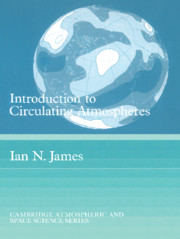Book contents
- Frontmatter
- Contents
- Preface
- Notation
- l The governing physical laws
- 2 Observing and modelling global circulations
- 3 The atmospheric heat engine
- 4 The zonal mean meridional circulation
- 5 Transient disturbances in the midlatitudes
- 6 Wave propagation and steady eddies
- 7 Three-dimensional aspects of the global circulation
- 8 Low frequency variability of the circulation
- 9 The stratosphere
- 10 Planetary atmospheres and other fluid systems
- Appendix: Solutions to Problems
- Bibliography
- References
- Index
8 - Low frequency variability of the circulation
Published online by Cambridge University Press: 14 January 2010
- Frontmatter
- Contents
- Preface
- Notation
- l The governing physical laws
- 2 Observing and modelling global circulations
- 3 The atmospheric heat engine
- 4 The zonal mean meridional circulation
- 5 Transient disturbances in the midlatitudes
- 6 Wave propagation and steady eddies
- 7 Three-dimensional aspects of the global circulation
- 8 Low frequency variability of the circulation
- 9 The stratosphere
- 10 Planetary atmospheres and other fluid systems
- Appendix: Solutions to Problems
- Bibliography
- References
- Index
Summary
Low frequency transients
In the preceding chapter, Fig. 7.14 compared the eddy correlation tensor for the higher frequency eddies, whose periods are less than around ten days, with the lower frequency transients. The high frequency eddy statistics have a well-defined structure in the midlatitudes, with maxima in the storm track regions. The high pass filter used in Chapter 7 served to isolate a specific family of dynamical processes, namely, those associated with baroclinic instability and the subsequent evolution of baroclinically unstable waves. The low frequency eddy kinetic energy is much less clearly structured. Figure 7.14 shows some evidence of maxima downstream of the high frequency maxima, as well as some correlation between the jet centres and maxima of low frequency variability. But none of these patterns is especially marked.
One reason for this is that the low frequency band covers a very wide range of frequencies. There are disturbances whose periods are very little longer than those of the baroclinic disturbances; indeed, the maxima downstream of the storm track centres are at least partly due to the occlusion and decay of midlatitude cyclones, which become slower moving as they fill. But there are also transients of significant amplitude with very much longer periods. Indeed, a spectral analysis of any long sequence of atmospheric data reveals that variability is observed on as long a period as one cares to specify.
- Type
- Chapter
- Information
- Introduction to Circulating Atmospheres , pp. 255 - 301Publisher: Cambridge University PressPrint publication year: 1994
- 3
- Cited by



